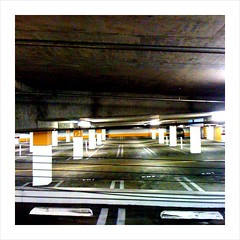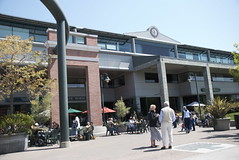- For a typical parking space, surface or structured, a spot can range between 320 sf to 430 sf gross per space, including aisles, corners, columns, landscaping, disabled, mechanical, ticketing, and more.
- 430 sf/space is for surface parking (no structure) and odd shaped sites with generous landscaping. This maximum size works out to about 100 spaces per acre (43,560 sf/acre / 430 sf/space = about 100 spaces/acre).
- 320 sf/space is for a large, efficient parking structure with clear span, double loaded, 90 degree parking, and parking around the entire perimeter.
- A relatively good number for standalone parking structure is 350 sf/space.
- For surface parking and parking structure, with building(s) above a useful size to estimate with is 400 sf/space.
- These parking spaces assume that the spaces are typically 90 degrees, 9 feet wide by 18 feet long with aisles of at least 24 feet wide. That would make a double loaded 90 degree parking bay 60 feet wide clear.
Wednesday, February 3, 2010
Parking Spots
Parking, so much to say. Let's start with size.
Wednesday, January 20, 2010
Los Angeles: The Grove
What stunning views big parking garages can get you. The Grove in Los Angeles has a path from the public parking garage that is on axis with the shops and plaza, making it a grand entrance and vantage point. The width of the path is about 35', which is generous enough for outdoor seating and other activities to occur. The buildings at the ground level hide the big parking structure. (It's ironic, but it seems that you have to have gigantor parking facilities if you want to motivate people to walk in LA.)
Cafe Borrone and Keplers, Menlo Park, CA
This mixed use building in Menlo Park was designed to be the town square. It is located a busy section of El Camino Real between Menlo Avenue and Santa Cruz Avenue. There are three active uses at the ground floor, BBC Pub, Cafe Borrone, and Kepler's Bookstore. People come to relax in a generous plaza that feels civic and spacious. It is approximately 75' from El Camino Real (where El Camino is 2 lanes each way, instead of the standard 3 lanes each way). While this may be one of the slowest sections of El Camino, it still moves along. The space is roughly 100' wide, which is a comfortable stage from which to watch people and the cars driving by. The two stories on top are commercial office space, and below there is underground parking. Behind the building is the Menlo Park Caltrain Station. It is one of the most urban examples of progressive development in the Bay Area.
Wednesday, December 9, 2009
Subway Architecture
 I've been working on two transit related projects, lately. (Thanks to the hope of Stimulus money). One of the biggest questions facing the cities that transit resides in, is whether to go underground or above ground. The forces of the economy seem to suggest that above ground options are more feasible. However, underground means that the experience of the city, at-ground-level, is more continuous and human scaled.
I've been working on two transit related projects, lately. (Thanks to the hope of Stimulus money). One of the biggest questions facing the cities that transit resides in, is whether to go underground or above ground. The forces of the economy seem to suggest that above ground options are more feasible. However, underground means that the experience of the city, at-ground-level, is more continuous and human scaled.The options, so often program is allocated in plan, are often to put the tracks side by side with the other uses intended to benefit or support the station. If we think vertically, there is the possibility of more connection within a smaller footprint.
Designboom is a website that looks at many aspects of design from industrial to interior to civic. There are some wonderful images of underground stations throughout the world that can serve as inspiration for thinking bigger.
Wednesday, November 4, 2009
Complete Streets
Here is a collection of the information out there for complete streets:
The Complete Streets Website http://www.completestreets.org/
APA Resources, including policy inventory and best practices manual
http://www.planning.org/research/streets/
Good photos here:
http://www.flickr.com/photos/38607288@N03/
(ITDP-Europe)
Information on Complete Streets and the Aging
http://www.aarp.org/makeadifference/advocacy/GovernmentWatch/StrongCommunities/articles/aarp_one_minute_guide_complete_streets_act.html
http://www.planetizen.com/node/28644
Advocates of Walking and indexing tool:
http://www.walkscore.com/
SF Bay Local:
Better Streets San Francisco
http://www.sfgov.org/site/uploadedfiles/planning/Citywide/Better_Streets/proposals.htm
Oakland
Walk Oakland, Bike Oakland
http://www.walkoaklandbikeoakland.org
The Complete Streets Website http://www.completestreets.org/
APA Resources, including policy inventory and best practices manual
http://www.planning.org/research/streets/
Good photos here:
http://www.flickr.com/photos/38607288@N03/
(ITDP-Europe)
Information on Complete Streets and the Aging
http://www.aarp.org/makeadifference/advocacy/GovernmentWatch/StrongCommunities/articles/aarp_one_minute_guide_complete_streets_act.html
http://www.planetizen.com/node/28644
Advocates of Walking and indexing tool:
http://www.walkscore.com/
SF Bay Local:
Better Streets San Francisco
http://www.sfgov.org/site/uploadedfiles/planning/Citywide/Better_Streets/proposals.htm
Oakland
Walk Oakland, Bike Oakland
http://www.walkoaklandbikeoakland.org
Barcelona's Innovation District
Columnist Neal Peirce (Seattle Times) wrote about Barcelona as a model of urban innovation.
Barcelona turned a depressed inner-city district into a high-powered knowledge hub by utilizing an ingenious form of real-estate development. The Spanish model is quite different from America's "free enterprise" approach to redevelopment.
"Their central idea: Talent is the gold of our time, crucial to building thriving new economic clusters. Talented people (and cutting-edge firms) want lively urban environments instead of the isolation of corporate campuses. They're anxious to brush shoulders with other gifted people from companies, universities and the artistic realm."
How does it work? Refer to the article for more information.
"Each of the district's 100-square-meter blocks — rather than individual land holdings — was made the basic unit for regeneration. Once 60 percent of landowners in any one of the 115 blocks agree to act collectively, they can — as a community — increase the value of their property by getting city permission to rebuild with greater height (more stories) than allowed in the past."
Barcelona turned a depressed inner-city district into a high-powered knowledge hub by utilizing an ingenious form of real-estate development. The Spanish model is quite different from America's "free enterprise" approach to redevelopment.
"Their central idea: Talent is the gold of our time, crucial to building thriving new economic clusters. Talented people (and cutting-edge firms) want lively urban environments instead of the isolation of corporate campuses. They're anxious to brush shoulders with other gifted people from companies, universities and the artistic realm."
How does it work? Refer to the article for more information.
"Each of the district's 100-square-meter blocks — rather than individual land holdings — was made the basic unit for regeneration. Once 60 percent of landowners in any one of the 115 blocks agree to act collectively, they can — as a community — increase the value of their property by getting city permission to rebuild with greater height (more stories) than allowed in the past."
The Green City of Freiburg
AK Greenbird's has a really informative blog entry on the City of Freiburg in Germany. It is one of the greenest (policywise) cities in the world. Optional district parking for residential uses, i.e. no parking and traffic on the streets, is one of the more progressive ideas implemented in Freiburg. (Can you see Americans parking away from their houses? Just imagine!) In addition, there are some astonishing public transit images (trams amidst a field of grass) and another blog entry on innovative stormwater reuse strategies. Freiburg showcases many examples of how to implement sustainability on a large, city-wide scale.
Subscribe to:
Posts (Atom)





